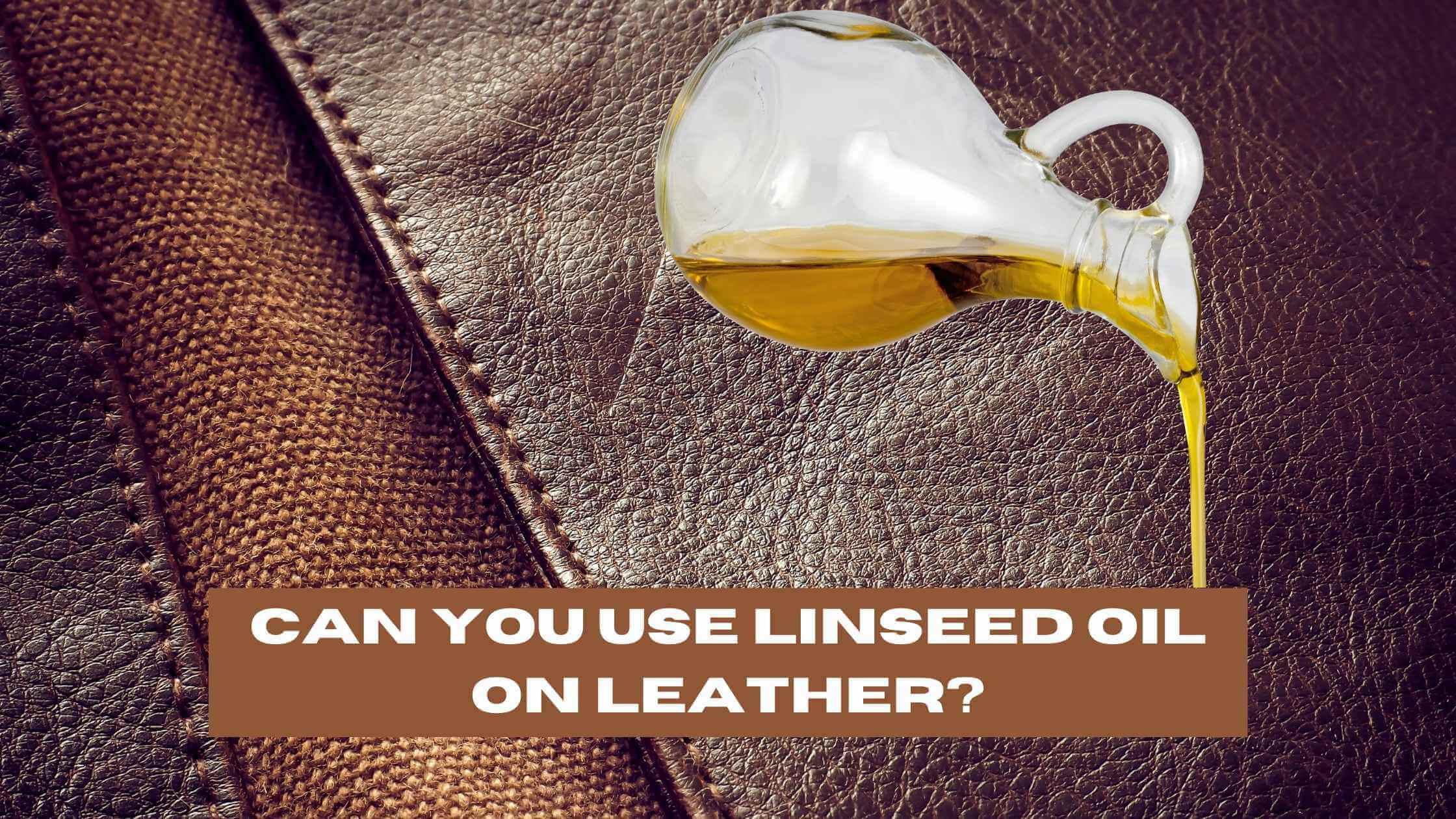You can try many oils with your leather if you’re searching for a natural treatment choice. But can you use linseed oil on leather? Here’s what I’ve got on it.
Linseed oil is not the best choice for leather boots, furniture, jackets, etc. While you technically can use it in a pinch, it can put your leather’s integrity at risk. It’s naturally a thick and heavy oil that can cause rot in your leather and takes a very long time to dry. If you want to use linseed oil for its natural properties and protective measures, it’s best to do it carefully. Don’t worry; I’ve talked about that below for you!
Key Points:
- Linseed Oil Risks:
- Linseed oil isn’t the ideal choice for leather items like boots, jackets, and furniture due to its thick nature.
- Using linseed oil can compromise leather integrity and potentially lead to rot, as it takes a long time to dry.
- Raw vs. Boiled Linseed Oil:
- Linseed oil comes in two types: raw and boiled.
- Raw linseed oil is unprocessed and used directly, while boiled linseed oil has been treated and mixed with other natural oils.
- Benefits of Linseed Oil for Leather:
- Linseed oil is natural and offers strong moisturizing abilities for leather.
- It serves as a deep-conditioning agent when applied carefully.
- Proper Application of Linseed Oil:
- Apply only a few drops to avoid overuse and potential drawbacks.
- Rub in small circular motions, then allow it to sit and absorb before wiping off residue.
- Precautions When Using Linseed Oil:
- Apply with light pressure to prevent overapplication.
- Understand the risks, determine if it’s worth using, and consider it a last resort.
- Know how to remove excess oil if needed to prevent permanent staining.
- Reapplication Frequency:
- Use linseed oil on leather no more than every six months to avoid over-conditioning and associated cons.
- Pros and Cons of Linseed Oil:
- Pros include natural composition, moisturization, mold prevention, and protective benefits.
- Cons encompass thickness, potential to stain light leather, strong odor, slow absorption, and the risk of causing leather rot.
What is linseed oil?
Linseed oil has been around for a long and comes from flax oil. There are two ways that it’s used in modern-day: raw or boiled. Raw linseed oil is unprocessed and is used straight in that form. Boiled linseed oil has been boiled, obviously, and blended with other kinds of natural oils to lighten it up.
Benefits of linseed oil for leather
So far, it sounds like there aren’t many positive attributes in favor of linseed oil and leather. There are some positive things that you can expect from this potent oil if you use it responsibly, though. I’ve listed the most important ones to consider below for you!
First and foremost, this is natural oil. Since many leather users and lovers focus on using only natural products, it’s nice to know this qualifies as an all-natural oil. Since it’s heavy oil, even when boiled, it’s got reliable, strong moisturizing abilities that make it a decent choice when searching for a deep-reaching conditioning agent for your leather!
Just ensure you know how to apply this heavy oil for your leather’s sake. The technique factors in here I’m going to go into that next to help you out.
How do you apply linseed oil to leather?
You’ll need only a few drops of this oil to get all its benefits. This is one natural oil that you’re not going to want to overuse since its potential cons are strong enough that you’ll find your leather much worse off after misusing it!
Dust your leather with a clean microfiber cloth, and then apply a few drops of this oil to your leather. Use your fingers and rub the oil in small circular motions to help massage it into your leather. Then let it sit for 24 hours or even longer so it has time to thoroughly sink into your leather. Then gently wipe off any remaining residue with a clean microfiber cloth.
Fun Fact: HGTV recommends blending linseed oil with vinegar for a natural cleaner and conditioner in one.
Precautions you should take when using linseed oil on leather
In all honesty, linseed oil is tricky to use with your valuable leather. Since its risks can easily outweigh its benefits, you’ll want to focus on learning about these precautions and how you can use them to keep yourself on the protective side!
When using linseed oil, keep a light hand. Use gentle pressure and carefully rub the oil into the leather as gently as possible. This oil doesn’t need to be convinced to sink into your leather. So, just keep a light pressure, and nature will do the rest!
You’ll also want to understand linseed oil’s risks for your leather. I’ll talk about those shortly, so stay tuned. But if you understand the risks, it’ll help you determine whether linseed oil is worth taking the risk. After all, it is a personal decision when all is said and done.
Similarly, most leather experts agree you’ll want to use it as a last resort. If you have nothing else available to condition your leather, or your leather is dried out and brittle and could use the heavy conditioning of linseed oil, it might be a good choice. But otherwise, it’s going to be all risk and little reward. Is that really what you want to get into?
My favorite precaution here is that you should know how to remove oil from your leather before you try to use it. If you’ve discovered that you’ve used too much or that your leather just isn’t benefiting from it, focus on how to remove it by:
- Remove excess oil with a microfiber cloth
- Sprinkle baking soda or talcum powder over the oiled surfaces
- Wipe off after 15 minutes
- Wash your leather using a cleanser
- Condition as normal
Sometimes oil can cause permanent stains in your leather, and this is particularly common with heavy linseed oil.
How often do you need to reapply linseed oil to leather?
You should use linseed oil on your leather no sooner than every six months. If you use it more often than that, you put your leather at further risk of its cons, and you also will generally over-condition your leather, which isn’t good for it!
Pros and cons of using linseed oil on leather
Okay, so now that you’ve heard all about the pros and cons, let’s get into them so that you can see for yourself what all of this fuss is about!
Pros of linseed oil on leather
- It’s all-natural
- It moisturizes like other types of oil
- It can prevent mold growth
- It helps protect your leather from damage
After all of the doom and gloom talk, it’s nice to know that there are some pros to consider, right? These benefits are worth noting, too, so don’t forget to think about them, especially in contrast to the cons, which are coming next.
Cons of linseed oil on leather
- It’s thick and can easily be overapplied
- It can stain light-colored leather
- It has a strong odor
- It can take a long time to sink in
- It can cause leather rot
If that last point contradicts the one about mold prevention above, that’s because it does! The right amount of it can prevent mold, but too much can rot out leather and its stitching. There’s a very fine edge that you’ll need to keep in mind when making your plans on applying it!
Now that we’ve got all of the disadvantages of linseed oil out in the open it’s easy to see why so many dedicated leather experts and general leather lovers, like myself, all recommend using it with extreme caution and only if you feel that you have no other choice for whatever reason.
Should I use linseed oil with my leather?
Come on, guys. You already know the answer to this! That’s right; it’s going to lean toward a “no” in most cases. As far as what your leather will benefit from, WikiHow recommends that you try almond oil, mink oil, lanolin oil, or neatsfoot oil.
It’s surprising to learn just how potentially risky linseed oil can be for your leather’s integrity. But it’s important to understand and then consider its advantages and disadvantages when it comes to your overall impression!
FAQ: Linseed Oil on Leather
Can You Use Linseed Oil On Leather?
Yes, you can use linseed oil on leather.
What is boiled linseed oil?
Boiled linseed oil is a type of linseed oil that has been treated with heat and chemicals to make it dry faster.
Can I use linseed oil on any type of leather item?
Linseed oil can be used on most types of leather, including full-grain, top-grain, and bonded leather.
How do I use boiled linseed oil on leather?
To use boiled linseed oil on leather, apply a small amount of oil to a clean, soft cloth and rub it gently onto the leather surface. Make sure to thoroughly coat the leather, and then allow it to dry for a few hours before using the item.
Is boiled linseed oil good for leather?
Yes, boiled linseed oil is good for leather. It helps to protect the leather, condition the leather fibers, and make the leather more flexible.
Can I use other oils, like coconut oil, on leather?
While coconut oil can be used as a leather conditioner, it is not as effective as linseed oil. Linseed oil penetrates deep into the leather, while coconut oil tends to sit on the surface of the leather.
What type of leather is linseed oil best for?
Linseed oil is suitable for use on all types of leather, including cowhide, sheepskin, and suede.
How much linseed oil should I use when conditioning leather?
It is important not to use too much linseed oil when conditioning leather. Only a small amount is needed to achieve the desired effect. Apply the oil sparingly and make sure to rub it in thoroughly.
Can linseed oil help prevent leather from cracking?
Yes, linseed oil helps to keep the leather moisturized and supple, which can prevent cracking and drying out.
Is linseed oil recommended for use on all leather goods?
While linseed oil is generally safe to use on leather, it is not recommended for use on leather items such as shoes or bags that come into frequent contact with moisture. The oil can stain and darken the leather if not properly applied or buffed.
Whether for your leather couch or leather accessories, linseed oil is considered too heavy as an oil to be reliable for the potential benefits of an all-natural conditioner that cares for your leather. It also contrasts with the disadvantages of smelling bad and taking a long time to dry after proper use. Mink oil and neatsfoot oil will be better alternatives for reliable moisturizing without the risk of ruining your leather!
If you know someone who would benefit from understanding the potential good and bad waiting in linseed oil and leather care, share this with them!

